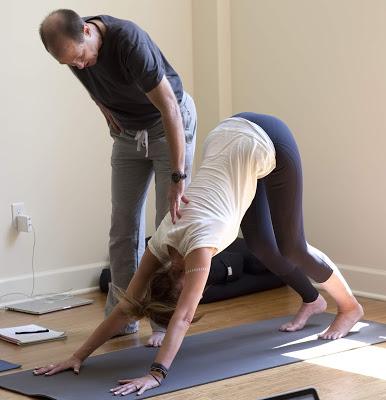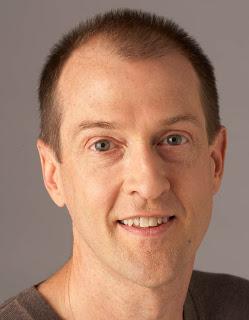 Nina: Welcome back to Yoga for Healthy Aging, Timothy! While many of our readers know who you are and realize that you used to write for our blog back in the day (see Farewell, Timothy McCall. And Thank You So Much!), there may be some of our newer readers who don’t know much about you. So why don’t you tell us a little bit about yourself?
Nina: Welcome back to Yoga for Healthy Aging, Timothy! While many of our readers know who you are and realize that you used to write for our blog back in the day (see Farewell, Timothy McCall. And Thank You So Much!), there may be some of our newer readers who don’t know much about you. So why don’t you tell us a little bit about yourself?Timothy: Thank you, Nina! It’s good to be back. My background is in medicine. I practiced as a specialist in internal medicine for about 12 years, before devoting myself 20 years ago to the study, practice, and teaching of yoga therapy. I write books, including my 2007 book Yoga as Medicine, which you helped with, in a few different ways, and which featured Baxter as one of the models. I’ve also been the Medical Editor of Yoga Journal since 2002. Besides writing, the thing that keeps me busiest is teaching yoga therapy workshops. Next month I’ll be leading trainings in Australia and New Zealand, which will be my first time in either country. I’m really excited because I’m planning to teach for 3 weeks and take 3 weeks in between workshops to explore and have fun. I don’t take as many vacations as I should, and I’m really looking forward to this trip!
Nina: And what have you been up to since you left California and stopped writing for our blog?
Timothy: Along with continuing to teach, I spent a couple of years co-editing and contributing to a medical textbook on yoga therapy called The Principles and Practice of Yoga in Health Care. The idea was to collect the scientific research on yoga in one place, and to present that information to health care professionals. Our goal, of course, was to get them to think about incorporating yoga and yoga therapy into the care of their patients. And, as you know, two years ago I got diagnosed with cancer, a stage IVa squamous cell carcinoma on my tonsil that metastasized to three lymph nodes on the opposite side of my neck. So that’s kept me busy….
Nina: We here at Yoga for Healthy Aging, along with most people in your life, had no idea that you were undergoing treatment for cancer until last June when you made an official announcement about both having throat cancer and having written a book about alternative therapies you used to support you through your treatments. Can you tell us something about what motivated you to write your personal story in Saving My Neck, which is a very different kind of book than Yoga as Medicine?
Timothy: When I went got diagnosed just before Thanksgiving 2016, I decided to kept it private. I know I would have received a lot of support from my friends in the yoga world, but I just felt like I needed to just get through the treatments. That still feels like the right decision. I initially had no intention of writing about it, but I learned so much along the way, I felt like I had to. To make the decisions I faced at every step, I did a ton of research, and it took me in some surprising directions that affected what I did. I ended up applying many holistic approaches—including yoga and Ayurveda—to complement the chemotherapy and radiation I got. I’m convinced that what I did made a tremendous difference going through chemoradiation. These tools made the cancer treatment easier to bear, sped my return to normal function—and maybe even increased my odds of getting cured. So really the book, the full title of which is Saving My Neck: A Doctor’s East/West Journey Through Cancer, is the story of how someone with a background in both conventional medicine and holistic healing figured out what to do when faced with a life-threatening disease. It was an amazing learning experience for me – and transformational—and I hope it will be an eye-opener for readers, too.
Nina: Because our blog focuses on yoga, can you tell us some examples of how yoga supported you during your treatments for cancer?Timothy: Yoga supported me not just during my treatment but before, as I prepared, and after, as I tried to recover from the ravages of chemotherapy and radiation. During my treatments, the side effects limited what I could do. Some days just standing and lifting my arms over my head felt like too much. Even my go-to restorative pose, Viparita Karani (Legs Up the Wall pose) with a bolster under my pelvis became impossible after the first couple of weeks. I had so much inflammation in my mouth that after one minute in the pose, phlegm built up in my mouth and I’d start to cough. And coughing by that stage was extremely painful as all the tissues in my mouth and throat had been so badly traumatized.
What I found instead was supported prone Bharadvajasana. One of the most feared long-term aftereffects of head and neck radiation is fibrosis, stiffening of the tissues of the mouth and throat. So, this pose—lying my torso over a bolster, with my knees and head turned in the same direction—was not only restorative, but it gave a wonderful stretch to the tissues of my neck. I did it on both sides, and often a few times per day. I’d guess I averaged more than an hour a day in just that one pose!
Nina: You’ve been through so much. How does your practice continue to support you today?
Timothy: My strength and stamina have returned to what they were before I got sick, so I’m back to doing a stronger asana practice. One thing I did as I was recovering (and continue to do), which made a huge difference, was a very slow pranayama practice. I should caution readers that I’ve had a daily pranayama practice for 18 years, and I’ve worked up to long breath-holding very slowly over the years. What I did is not something that should be attempted without the proper preparation—and guidance from a teacher. That said, my daily practice for the last year has been a very slow Nadi Shodhana, alternate nostril breathing. Specifically, I inhale through one nostril for 16 seconds, hold my breath for 16 seconds, exhale through the opposite nostril for 16 seconds, and hold the breath out for another 16 seconds. Then I do it on the other side and repeat. So that means I’m breathing less than one breath per minute. I do it for about 20 minutes every morning. I’ve had a lifelong twitchiness of my nervous system and a major vata derangement—both likely due to early life trauma, which I describe in Saving My Neck. This practice, I believe, has had a huge impact on both of these. That and everything else I did to fight the cancer and deal with the treatments—and recover from them both—has left me healthier today (as far as I can tell!) and more balanced than I’ve ever been.
Nina: How would you say your experience with cancer applies to people who have other life-threatening illnesses?
Timothy: One of the central principles of holistic healing is that the treatment is not based on the medical diagnosis per se so much as it’s designed to address whatever imbalances a person has. In yoga therapy, we like to say, we treat people, not conditions. In the therapy work I do, I divide up the territory of mind, body, and spirit into five categories, using an acronym SNAPS. That stands for Structure, Nervous System and Breath, Ayurveda, Psychology, and Spirituality. The way I treated any problem, including the many I faced on this journey through cancer, was to address as many aspects of my being as my time and energy allowed. So, I did yoga practices and bodywork to work on my structure, I chanted and did breath work for my nervous system, I meditated, I worked to balance myself from an Ayurvedic standpoint, and I tried to deal skillfully with the psychological challenges that a cancer diagnosis presents. Once I’d started to recover from treatment, I noticed a growing hunger—more urgency than I’ve felt for years – to do what I feel like I’ve been put on the planet to do. And writing Saving My Neck—which as you mentioned, is a memoir and is very different than anything I’ve written before—was a process of discovery, as I examined every aspect of what I’d been through. This process took me even deeper on the path of yoga.
Nina: Is there anything else you’d like to tell our readers?
Timothy: I’d just like to thank everyone in the yoga world for all the love and support that I’ve received since I went public with my cancer diagnosis last summer. People have reached out to me to say how much my work has meant to them, in a way I’d never heard before. It all has been incredibly gratifying.
And if I could just say one more thing about Saving My Neck: I’ve decided to publish it myself rather than using a mainstream publisher. This one feels more personal than my other books, and I wanted to be able to control every aspect, from who edited it to the quality of the paper it gets printed on. But indie publishing doesn’t have the marketing and publicity clout of conventional publishing, so I’m reaching out to the yoga world. If you read the book and it speaks to you, please help spread the word. Thank you all!


Subscribe to Yoga for Healthy Aging by Email ° Follow Yoga for Healthy Aging on Facebook and Twitter ° To order Yoga for Healthy Aging: A Guide to Lifelong Well-Being, go to Amazon, Shambhala, Indie Boundor your local bookstore.

